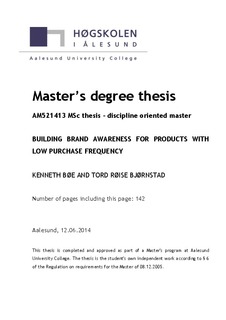| dc.description.abstract | The importance of marketing and information flow is growing every year, and in increasingly competitive markets, it is more important than ever for brands to be present in the customers mind in the purchase decision. Therefore, to build and maintain brand awareness is important as this is the first step in creating brand equity. Most studies have focused on building brand awareness for products with high purchase frequency.
In this thesis, it is identified drivers of brand awareness for products with low purchase frequency. Our research question is: How to build brand awareness for products with high involvement and low purchase frequency? This thesis is based on a quantitative survey in the Oslo-region distributed to 220 respondents. The survey was conducted using a web panel, with assistance from Ipsos MMI. The respondents were people who had claimed to have an interest in furniture products.
The findings in this study indicate that Wonderland has low brand awareness in the Oslo-region, and it is therefore of particular interest to identify which drivers that are most important in building brand awareness in this region. Wonderland is perceived as a low purchase frequency product. In this thesis, low purchase frequency is defined as products bought less frequently than seven years. The low purchase frequency product is perceived as high involvement, which means that the customers invest time and energy to gather information prior to purchase.
The result from this thesis indicates that distribution intensity and advertising both contributes significantly and positively to brand awareness. Distribution intensity is shown to be the most important driver of brand awareness, as the concept is significant and positive with both product involvement and brand awareness. As the involvement for low purchase frequency product increases, the more important is the distribution intensity for increasing brand awareness. This means that the more involved the customers are in the buying process, the more important is distribution intensity which in turn increase brand awareness.
This thesis also supports previous findings that brand awareness, loyalty, perceived quality and purchase decision is significantly related. | nb_NO |

